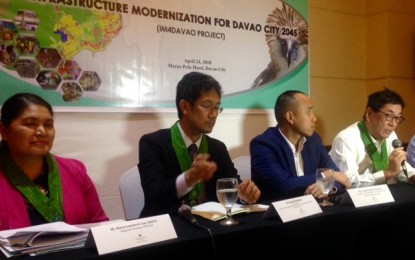
DAVAO CITY -- The Davao City government and the Japan International Cooperating Agency (JICA) on Tuesday bared a "shopping list" of major infrastructure projects worth almost PHP300 billion to address existing conditions and issues in city, especially on the effects of urbanization.
Called the Davao City Infrastructure Development Plan and Capacity Building project for the Infrastructure Modernization for Davao or IM4Davao 2045, it is 27-year infrastructure plan with a list of proposed projects for Davao City that investors and funding agencies can select from.
“It is a platform for all agencies and stakeholders. A platform for the development of development,” said Ken Kumazawa, leader of the IM4Davao Project Team.
The draft of the final report was presented to agencies and stakeholders at the Marco Polo Hotel. It contains the existing conditions of the city’s water system, traffic, and other environmental issues.
IM4Davao is being developed by the city government together with JICA and Almec Corporation Oriental Consultants Global Ltd.
The plan is expected to improve the city’s competitiveness, safety from disasters, and general urban conditions. It will support the planning and implementation of development - effectively and efficiently - through the capacity enhancement of the National Economic Development Authority (NEDA) and the city government.
Kumazawa said there are priority projects on the list, from highway network, public transport, wastewater management, solid waste management, environmental management, and planning and implementation capacity.
He said the city government saw the need to create an infrastructure plan because it is expected to perform key regional and international roles being the seat of Davao region.
In a press briefing also held at the Marco Polo Hotel on Tuesday, Assistant City Administrator Tristan Dwight Domingo said the IM4Davao guides the city on how it will pursue infrastructure development. It will also raise accountability.
“This is a list which can serve as a basis of specific things we can request from the national government to help us with or to fund,” he said.
It is also a show window for the people to see the bad effects of urbanization. Domingo said people can also check the performance of the government.
“We encourage people to learn more about the plan,” he said.
Some of the projects are already subject to funding while others are on-going. NEDA director Maria Lourdes Lim hopes other projects will obtain grants so that these can be started.
She said the other components of the masterplan will have to go through a rigorous evaluation or appraisal process and the appropriate financing scheme.
“Having these projects, for example, in the public investment program which is being managed by NEDA, that will be a signal not only to our government but also to our ODA (Official Development Assistance) partners and even private sector through PPP (public-private partnership) that we want to make Davao City as, perhaps, the most competitive and livable city in the southern Philippines,” Lim said.
The report presented on Tuesday detailed the issues currently confronting the city.
These are the degrading water quality of the Davao River with its high fecal coliform and total suspended solids; traffic problem; and, urbanization trend, particularly on the rapid increase of the city’s population in 30 years from less than a million in 1985 to 1.6 million in 2015.
In its population forecast, the report said Davao City plus the six adjacent local government units could reach 5.2 million in 2045 from 2.5 million in 2015 population count.
To address bottlenecks and new roads, the list includes short-term projects such as the completion of the Davao City Bypass road; completion of the Davao City Coastal Road; secondary routes between the bypass road and Diversion road; and, the establishment and operationalization of the Davao City Traffic Control Center.
For mid-term (2023-2030), the list includes the extension of Diversion road to Toril; the construction of Davao Riverside Boulevard together with river improvement; and, secondary roads to serve newly-urbanized areas.
The long-term projects (2031-2045) are the construction of the Buhangin-Bunawan Bypass Road; construction of the Talomo-Calinan Bypass Road; and continuous secondary road development.
There is also the railway network plan, a combination of the ongoing Mindanao Railway with the proposed Davao City Mass Transit Line.
Lim said the projects are even aligned with the 10-point development agenda of Mayor Sara Duterte.
Lim also underscored stakeholders' participation and support.
“This plan will not be realized without the support of the stakeholders,” Lim said. (Lilian C. Mellejor/PNA)
